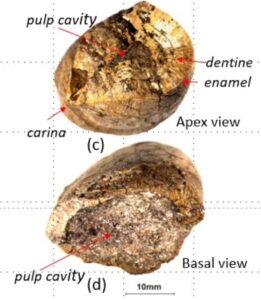Meghalaya was home to long-necked dinosaurs
In NE, first-time discovery of fossilised teeth from South West Khasi Hills

Shillong, May 20: Palaeontology Division, Geological Survey of India (GSI), North Eastern Region, Shillong is jubilant over the discovery of dinosaur teeth in South West Khasi Hills.

The first-time discovery of the fossilised teeth in the North East was on January 8 this year but the announcement was delayed pending completion of procedures, said Bashisha Iangrai, senior geologist, Palaeontology Division, GSI, who is passionate about working more for similar finds with her team.
The discovery was of Titanosaurian sauropod teeth from Mawphuli village near Ranikor during the field season 2023-24.
Titanosaurian sauropods, the last of the long-necked dinosaurs, went extinct along with others around 65 million years ago probably due to the impact of the fall of asteroid but not before roaming the earth for 165 million years.
South West Khasi Hills also faced the asteroid impact considering the presence of fossilised parts of dinosaurs which are gradually being unearthed.
Two titanosaurian sauropod teeth were discovered from South West Khasi Hills.They were preserved in the sandstone of the Mahadek Formation of Upper Cretaceous age (Maastrichtian, 72.1 million to 66 million years). Similar Titanosaurus teeth have been reported from Argentina, Morocco, Uzbekistan and Australia. In India, the Sauropod dinosaur belonging to the Titanosaurian clade has been reported from Lameta formation of Gujarat, Madhya Pradesh and Maharashtra, and Kallamedu formation of Tamil Nadu. The discovery in Meghalaya not only fills the gap in the stratigraphical record of Titanosaurian sauropods but also allows a better understanding of the distribution and diversity of vertebrates in the Late Cretaceous formations of India, said the GSI Public Relations Officer Dr Bashab N Mahanta.
Past discoveries from Khasi Hills
In 1977, Sinha NK and Mathur AK reported the first ever fragmented vertebrate bone fossils which was confirmed by Mishra UK and Sen. S in 2001 as dinosaur bones from the upper part of the glauconitic sandstones of Upper Cretaceous Mahadek Formation of Khasi Group near Nongnah, South West Khasi Hills.

Later, Maharana CR, Nath TT and Angami JK in 2006-2007 and Iangrai B and Dalabehera L in 2019-2021 had reported the occurrence of several fragmentary and disarticulated dinosaur bones from Dirang and Mawphuli, South West Khasi Hills and identified a partially preserved limb bone comparable with an average humerus length of Titanosaurids reported from the late Cretaceous Lameta Formation of Jabalpur, Madhya Pradesh and Rahioli, Kheda District, Gujarat.
“This, however, is the first-ever reporting of dinosaurian teeth-fossils in the Northeastern part of India. Earlier many workers had reported the occurrences of fragmentary and disarticulated Sauropod dinosaur bones from Meghalaya”, the PRO said.

Sauropod teeth from the Upper Cretaceous Mahadek formation are exposed in Mawphuli village where numerous fragmentary and broken vertebrate bones of Titanosaurian affinity are present. The two poorly preserved teeth were recovered from the coarse grained, gritty, purplish arkosic sandstone of the Mahadek Formation, Khasi Group of Upper Cretaceous (Maastrichtian) age. Although the complete tooth is not preserved, based on the morphology, both the teeth are comparable to teeth of Sauropods of Titanosaurus of late Cretaceous age as reported from the rest of the world.
In both the teeth, the apex and wear facet are missing and are of different size and shape Smaller tooth is chocolate brown in colour in the crown portion and off-white in the base and is 16 mm long (Longitudinal axis) with basal diameter of 5 mm. The mesiodistal diameter is 5.5 mm. The tooth has distally straight crown without well-developed root. Crown is slightly expanded above the root and has a blunt apex and longitudinal ridges (carina) on the labial and lingual sides, which lend a rhomboid outline to its cross-section. The apex is asymmetrical in labial/lingual view. The pulp cavity is narrow and filled with ferrous stains along the fissures at the base. The cross-section of the base is semi-circular to circular with radiating structures. The enamel is very thin with wrinkled texture at the base of the crown and has thick dentine.
The bigger tooth is yellowish in colour, 23 mm long and 20 mm wide and shows distinct crown-root transition and wrinkles on the thin enamel. The basal diameter is 18 mm and cross section looks D-shaped/lemon shaped. Carina (the lateral ridge) is also preserved . The enamel and dentine with pulp cavity is filled with purple colored sediments.
Both the specimens have similarities with Titanosaurid sauropod of late Cretaceous on the basis of its size, shape and tooth morphology. Similar Titanosaurus teeth have been reported from the Anacleto and Allen formations of Argentina, Kem Kem beds of Morocco, Bissekty formation of Uzbekistan and Lower-Upper Cretaceous Winton Formation of Queensland, Australia.
In India, the late Cretaceous sauropod dinosaur belonging to the Titanosaurian clade has been reported from the Lameta Formation of Gujarat, Madhya Pradesh and Maharashtra, and Kallamedu Formation of Tamil Nadu in 2019. These reporting of the Sauropod assemblage of Titanosaurian affinity from Meghalaya not only fills the gap in the stratigraphical record of Titanosaurids, but also allows a better understanding of the distribution and diversity of vertebrates in the late Cretaceous formations of India, the GSI official said.






